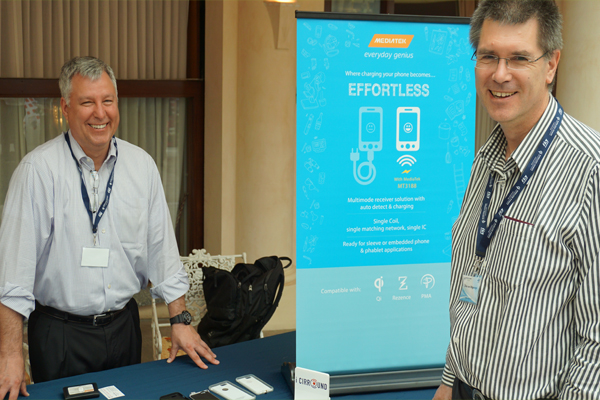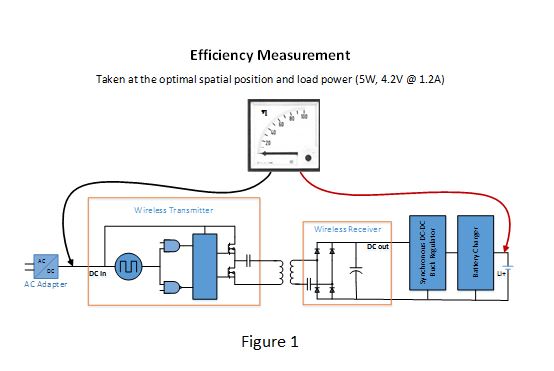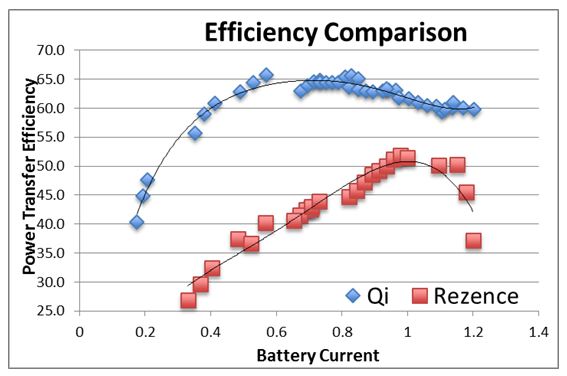WPC-Commissioned Study Finds Qi Wireless Charging More Efficient Than Rezence
A new study conducted by Colorado State University (CSU) and commissioned by the Wireless Power Consortium (WPC), which is behind the Qi standard for wireless power, showed that Qi's inductive charging is more efficient in terms of energy use than the competing standard, Rezence.
Rezence, a wireless power standard that uses resonance charging, can cover a wider area for charging devices, such as an entire table surface. Qi, on the other hand, can only charge a device in a fixed location. The Rezence standard is now being developed by the Alliance For Wireless Power (A4WP). The consortium recently merged with the Power Matters Alliance, the creators of Powermat, to better compete against the fast-growing Qi standard.
The battle between WPC's Qi standard for inductive charging and A4WP's Rezence for resonant charging hasn't yet been settled. In fact, some companies have even started using them together rather than picking between them. Right now, at least, the two standards are also more complementary rather than directly competitive, so it makes some sense to use them together, unless the licensing costs are prohibitive for most manufacturers.
The A4WP called Rezence the next generation of wireless power because it can charge devices that are within a short distance. However, Qi has at least one significant advantage compared to Rezence, and that's efficiency in power usage.
Colorado State University tried to find a more standardized way to measure efficiency for both Qi and Rezence wireless charging systems that isn't biased towards either one of them. Therefore, it came to the conclusion that the efficiency should be calculated as follows: "DC power into the battery divided by DC power into the transmitter with a 5W battery load (4.2V at 1.2A)."
The University believed that this would be the optimal way to measure efficiency because it reflects the power needs of a smartphone, which is currently the typical use case for wireless charging.
In the test, CSU researchers tested a commonly-used A11 transmitter coil for Qi charging. For Rezence, it tested a system from Efficient Power Conversion (EPC), which uses Gallium-Nitride output switches, a zero-voltage switching (ZVS) output topology and the NuCurrent antenna set compliant to the A4WP class-3 spec -- all of these giving maximum efficiency as far as a Rezence system goes, according to the WPC.
Get Tom's Hardware's best news and in-depth reviews, straight to your inbox.
The test results showed that in most cases where the transmitter and receiver are in close proximity, such as having charging pads on which to rest your smartphone, Qi charging is optimal as it provides the highest efficiency (and therefore the fastest charging time).
Rezence can lose more than 800mW of power due to its high-operating frequency. However, the WPC also said that it may be appropriate sometimes to sacrifice some energy efficiency to reach a greater distance. That's why some of the Qi backers are also backing Rezence.
Although smartphones may not necessarily need Rezence charging, it could be significantly more convenient, for instance, to charge electric cars this way in the future. All parking spots could be powered by Rezence, or perhaps an even longer-distance wireless charging technology, and the cars would just need to park and be charged at the same time.
We should also note that a study commissioned by one group that proves their superiority in any way to a competitor is to be taken with a grain of salt.
Follow us @tomshardware, on Facebook and on Google+.
Lucian Armasu is a Contributing Writer for Tom's Hardware US. He covers software news and the issues surrounding privacy and security.
-
Omegaclawe In other news, the sky is blue, the Pope is Catholic, and steel beams can't melt jet fuel.Reply
But seriously, longer range is going to be less efficient. Particularly with wireless, what with having to cover an area rather than just add length to a cable. -
Xyne Still pretty biased, what about eff vs. distance (both will integrate charging pad in furniture and other things which typically adds small additional distances between coils). And what about placing accuracy vs eff (typical users will place coils not exactly center above center)?Reply
Too sloppy and narrow study, there should be scientific method and a wide variety of tests to cover most use-cases. -
Efficiency between 30 to 50%? That's very wasteful.Reply
What about the project to create space solar stations that would transmit electricity back to earth? I don't think distance is the problem. Instead of pads, they should be smartly shaped "docks" where the phone rests in an exact position, so the receptor receives all the output. -
zodiacfml lol?! duh?!Reply
This is the reason why even Rezence existed. The Qi is naturally more efficient but has very poor practicality. I'd prefer wired charging as I can use the phone while it charges, faster charging, and a million times more efficient.
The Rezence tries to improve on the Qi by allowing a bigger surface and multiple devices. Still, not practical in y opinion.
Wireless charging cars would be far fetched as distance drastically drops the efficiency as can be seen from the study above. Contact less charging is what we're talking about here where a surface automatically raises very close to an underbody of a parked car for charging. -
billyboy999 30% efficiency may sound terrible but we're talking about charging smartphones here. Running the microwave for 1-2 minutes will consume more power than fully charging any smartphone. The cost of the electricity used is less than a cent. As long as we're talking double digit efficiency I honestly don't think it's that big a deal.Reply -
Reply
lol?! duh?!
Wireless charging cars would be far fetched as distance drastically drops the efficiency as can be seen from the study above.
As I stated above, this is false. Search "Space-based solar power" on wikipedia, you'll see that distance ins't a factor.
"Between 1969 and 1975, Bill Brown was technical director of a JPL Raytheon program that beamed 30 kW of power over a distance of 1 mile (1.6 km) at 84% efficiency."
It's amazing how people think distance reduces energy. Remember inertia? Photons from the sun reach us full blast. Well, those that reach us anyway. Which is the real problem. -
eklipz330 Reply30% efficiency may sound terrible but we're talking about charging smartphones here. Running the microwave for 1-2 minutes will consume more power than fully charging any smartphone. The cost of the electricity used is less than a cent. As long as we're talking double digit efficiency I honestly don't think it's that big a deal.
well it will be more of a problem when there's serious mainstream adoption, im talking every device. it's not too far to see restaurant chains including these sort of charging options to users. i wouldn't be surprised if batteries began shrinking because of how close these chargers will be in proximity. that's when it will become an issue.
-
Vlad Rose Better yet, don't be lazy and plug a device in. There's much higher efficiency that way and you can help save the planet. ;)Reply
Not to mention the fact that is proven that it's not healthy for the body to be in the presence of wireless power or EMI. Look at the cases of cancer in relation to distance to power lines; or studies linking cancer to cell phone usage (controversial). To me it just doesn't seem worth it for the sake of 'convenience'. -
AlexLidow The reporting of the Colorado State report has a number of false and misleading assumptions in the WPC-sponsored Qi/A4WP efficiency study hence they have a vested interest in the outcome, skewed towards their self-interest. Some of the more important egregious assumptions are listed here:Reply
1. The EPC wireless charging kit that was used as a representative of the Rezence standard was designed for power up to 38 W, much higher than the power load of 5 W, which is the Qi standard. Given that ALL power electronic systems exhibit lower power conversion efficiencies at lower power than for which they are designed, the efficiency numbers reported does not reflect the true conversion efficiency capability of the EPC system. The EPC system, although using A4WP based components, is not A4WP compliant.
2. The device (receiving) board used in the EPC kit was tuned for higher output voltage; so driving to a higher current (twice the design current used in the Colorado State study) will have a negative impact on both the device board and source (transmitting) system.
3. The efficiency comparison in the study was made using a 16 W-rated, multi-load coil set operating at one-third the rated power. If the comparison were made using an A4WP class 2-source coil (10 W rated), the efficiency of the EPC system would have been much higher.
4. Most noticeably, the study increased the distance between the transmit and receive coils of the EPC system beyond that specified by the A4WP standard, which placed the system at a disadvantage. This matters as the Qi-based system uses a fixed alignment and very tight well-defined spacing between the coil sets. The A4WP standard does specify a very specific distance between the coil sets based on a “use case” scenario. Increasing the distance for the A4WP system effectively placed it outside of the standard to which it was designed and tested.
Upon reflection, the Qi-financed study raises a fundamentally good question about the need to define and measure conversion efficiency. However, because of the difference in structure of the various wireless power standards, intra-standard comparisons of systems are straight forward and easily defined, whereas inter-standard comparison of systems designed under different wireless power standards requires far more diligence to adequately define that will result in a trustworthy comparison.


